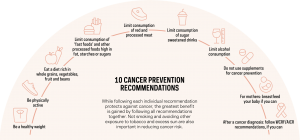Body Weight, Physical Activity, Diet & Alcohol
Excess body weight, alcohol consumption, unhealthy diet and physical inactivity are important modifiable cancer risk factors.
Excess body weight (i.e., overweight and obesity) increases risk of 13 types of cancer, and in 2012 accounted for 3.6% of all new cancer cases among adults worldwide. The global prevalence of excess body weight has increased: in 2016 an estimated 39% of men and 40% of women aged 18 years and older, and 27% of boys and 24% of girls aged 5–18 years, were obese. (Map 1a & b) High amounts of sugar-sweetened beverages, and sedentary behaviors, including screen-time, increase risk of excess body weight, whereas aerobic physical activity, including walking, reduces risk. (Figure 1)
10 Cancer prevention recommendations. While following each individual recommendation protects against cancer, the greatest benefit is gained by following all recommendations together. Not smoking and avoiding other exposure to tobacco and excess sun are also important in reducing cancer risk. 1. Be a healthy weight. 2. Be physically active. 3. Eat a diet rich in whole grains, vegetables, fruit and beans. 4. Limit consumption of ‘fast foods’ and other processed foods high in fat, starches or sugars. 5. Limit consumption of red and processed meat. 6. Limit consumption of sugar sweetened drinks. 7. Limit alcohol consumption. 8. Do not use supplements for cancer prevention. 9. For mothers; breastfeed your baby if you can. 10. After a cancer diagnosis: follow WCRF/AICR recommendations, if you can.
Alcohol consumption is known to cause cancers of the oral cavity, pharynx, larynx, esophagus, liver, colon, rectum, and female breast. Worldwide, in 2016, 4.2% of cancer deaths were attributed to alcohol consumption. (Figure 2)
Independent of effects on body weight, a healthy dietary pattern rich in plant foods, including fruits, non-starchy vegetables, whole grains, and legumes (e.g., beans), and low in red and processed meats, reduces risk of certain cancers, particularly colorectal cancer. Independent of effects on body weight, physical activity reduces risk of some types of cancer, specifically colon, and among women, breast and endometrial cancer. Globally, 23% of adults did not meet World Health Organization physical activity guidelines in 2010, and more than 80% of adolescents were insufficiently physically active.
Figure 2. Proportion of cancer deaths attributable to alcohol (%) by site, 2016. In 2016, 31% of pharynx (excluding nasopharynx) cancer deaths were due to alcohol; 26% of lip and oral cavity cancer deaths; 22% of larynx cancer deaths; 17% of esophagus cancer deaths; 11% of colon and rectum cancer deaths; 10% of liver cancer deaths; and 5% of breast cancer deaths.
Movement is a medicine for creating change in a person's physical, emotional, and mental states.
Reversing the obesity epidemic, limiting alcohol consumption (among those who drink), and increasing the prevalence of healthy eating and active living hold considerable potential for reducing cancer incidence and mortality, which will require a comprehensive approach involving actions by institutions and individuals at all levels from national to local communities.
Alcoholic beverage consumption:
International Agency for Research on Cancer. IARC Monographs on the Evaluation of Carcinogenic Risks to Humans: Alcohol consumption and ethyl carbamate. Vol. 96. Lyon, France: IARC Press; 2010.
Department of Health and Human Services [USA] 2018 Physical Activity Guidelines Advisory Committee. 2018 Physical Activity Guidelines Advisory Committee Scientific Report. Washington, DC: U.S. Department of Health and Human Services, 2018. https://health.gov/paguidelines/second-edition/report/ Accessed Feb. 28, 2019.
Text:
Arnold M, Pandeya N, Byrnes G, et al. Global burden of cancer attributable to high body-mass index in 2012: A population-based study. Lancet Oncol. 2015 Jan; 16(1): 36–46.
Department of Health and Human Services [USA] 2018 Physical Activity Guidelines Advisory Committee. 2018 Physical Activity Guidelines Advisory Committee Scientific Report. Washington, DC: U.S. Department of Health and Human Services, 2018.
https://health.gov/paguidelines/second-edition/report/
International Agency for Research on Cancer. IARC Monographs on the Evaluation of Carcinogenic Risks to Humans: Alcohol consumption and ethyl carbamate. Vol. 96. Lyon, France: IARC Press; 2010.
Lauby-Secretan B, Scoccianti C, Loomis D, et al. Body Fatness and Cancer: Viewpoint of the IARC Working Group. N Engl J Med. 2016;375:794–798.
World Cancer Research Fund/American Institute for Cancer Research. Diet, nutrition, physical activity and cancer: A global perspective. Continuous Update Project Expert Report 2018. Available at dietandcancerreport.org. Accessed Nov. 9, 2018.
World Health Organization. Global status report on alcohol and health 2018. Geneva: World Health Organization; 2018. https://www.who.int/substance_abuse/publications/global_alcohol_report/en/ Accessed Feb. 28, 2019.
World Health Organization. Obesity and Overweight. http://www.who.int/gho/ncd/risk_factors/physical_activity_text/en/ Accessed October 30, 2018.
Map:
Adult obesity is defined as BMI greater than or equal to 30.
World Health Organization Global Health Observatory Data Repository. https://www.who.int/gho/en/. Accessed May 30, 2019.
Figure 1:
World Cancer Research Fund/American Institute for Cancer Research. Diet, nutrition, physical activity and cancer: A global perspective.
Continuous Update Project Expert Report 2018. Available at dietandcancerreport.org.
Figure 2:
World Health Organization. Global status report on alcohol and health 2018. Geneva: World Health Organization; 2018. License: CC BY-NC-SA 3.0. See page 89 of the report.
